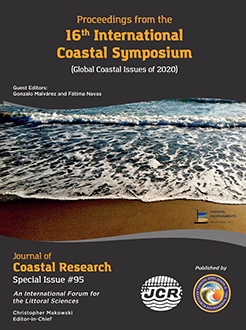Billy, J.; Baudouin, V.; Portal, A.; Deparis, J.; Bitri, A., and Garcin, M., 2020. An innovative approach for a comprehensive characterization of coastal dune systems through internal architecture and the associated intrinsic geophysical properties. In: Malvárez, G. and Navas, F. (eds.), Global Coastal Issues of 2020. Journal of Coastal Research, Special Issue No. 95, pp. 387–391. Coconut Creek (Florida), ISSN 0749-0208.
Comprehensive geophysical sub-surface investigations of coastal systems provide a better understanding of the organization of sediment deposits and the behavior of coastal areas. An innovative high yield multi-geophysical approach has been developed to investigate internal properties of coastal dunes and their associated environments, combining continuous, multiscale and non-destructive methods: (i) terrestrial seismic surveys MASW, (ii) electrical resistivity tomography and (iii) ground-penetrating radar. This approach was deployed to characterize a complex sandy dune system at the Pays-De-Monts (Atlantic Coast, France), a 27-km-long and 0.6-2-km wide coastal system composed of three generations of dunes (4 to 25 m high) separated by former marshes or large slack areas. This paper focuses on the most seaward dunes (over a width of 600 m with 5-6 m high dunes) at La Parée Grollier, in the northern part of the Pays-De-Monts. It shows a cross-interpretation analysis of the multiple geophysical results, along a same profile, and highlights the power of such approach to characterize coastal dune system by an innovative way. Data allowed the differentiation of (i) three seismic layers (SU1-3), (ii) eight electrical resistivity bodies (EU1-8), and (iii) six GPR units (RU1-6), characterizing subsurface deposits at large scale, medium scale and with details, respectively. Data interpretation of the combine methods highlights: (1) the entire sediment cover up to the substratum; (2) the detail internal architecture and connection between the different components of the dune system; and (3) consistent correlation between the georadar and geo-electrical results through the sandy dune. Such knowledge of intrinsic parameters of coastal systems is essential to advance geo-mechanical interpretations, to 3D-modelize coastal zone and to predict realistic scenarios of longshore and cross-shore coastal systems evolution, and to enhance coastal zone management.





